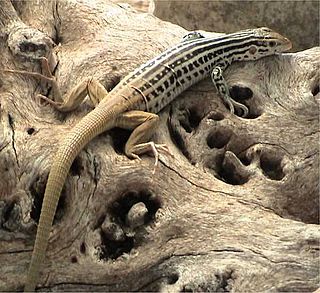
Laemanctus is a genus of lizards in the family Corytophanidae. Species in the genus Laemanctus are commonly referred to as conehead lizards or casquehead iguanas. The genus is endemic to Central America.

Typhlosaurus is a genus of African lizards, one of a number of genera of limbless lizards in the skink family (Scincidae). This group was recently revised with most species formerly attributed to Typhlosaurus now placed in Acontias. The current definition of Typhlosaurus includes five attenuate body legless lizards from southwestern Africa. This is the sister genus to Acontias, which together form the well supported Afrotropical subfamily Acontinae.

Diploglossus is a genus of New World diploglossid lizards, with 20 described species, commonly known as galliwasps.

Aspidoscelis is a genus of whiptail lizards in the family Teiidae.

The western whiptail is a species of lizard in the family Teiidae. The species is found throughout most of the southwestern United States and northern Mexico. Most of its populations appear stable, and it is not listed as endangered in any of the states comprising its range. It lives in a wide variety of habitats, including deserts and semiarid shrubland, usually in areas with sparse vegetation; it also may be found in woodland, open dry forest, and riparian growth. It lives in burrows. Major differences between this species and the checkered whiptail include the lack of enlarged scales anterior to the gular fold and the presence of enlarged postantebrachial scales. It was previously known as Cnemidophorus tigris, until phylogenetic analyses concluded that the genus Cnemidophorus was polyphyletic. Since it does not migrate, a number of forms have developed in different regions, several of which have been given subspecific names – for example the California whiptail, Aspidoscelis tigris munda.

Ctenosaura pectinata is a species of moderately large lizard in the family Iguanidae. The species is native to western Mexico.

The Texas spotted whiptail is a species of long-tailed lizard, in the family Teiidae. The species is endemic to the south central and southwestern United States and northern Mexico. Six subspecies are recognized as being valid.

Sceloporus grammicus is a species of lizard from Mexico and the southern United States. It is sometimes referred to as the mesquite lizard or graphic spiny lizard.

Sceloporus variabilis, commonly known as the rose-bellied lizard, is a species of lizard which is found from Central America to southern Texas

The little striped whiptail is a species of lizard found in the southwestern United States and in northern Mexico. A significant amount of research was done on the species during the mid-1990s, with several new subspecies being added, many of which some sources consider to be distinct enough to warrant full species status, and the research is ongoing. It is called little to distinguish it from many other species known as striped whiptails and to indicate that it is the smallest of those species.

The eastern casquehead iguana is a species of lizard in the family Corytophanidae. The species is native to Mexico and Central America.

Wiegmann's tree lizard is a species of lizard in the family Leiosauridae. The species is endemic to South America.

Fitzinger's algyroides, also commonly called the pygmy algyroides and the pygmy keeled lizard, is a species of lizard in the family Lacertidae. The species is native to the islands of Corsica and Sardinia in the Mediterranean. There are no subspecies.

Abronia deppii, Deppe's arboreal alligator lizard, is an endangered species of arboreal alligator lizard in the family Anguidae. The species was described in 1828 by Arend Friedrich August Wiegmann, and it is endemic to Mexico.

Holcosus undulatus, also known commonly as the barred whiptail, the metallic ameiva, and the rainbow ameiva, is a species of lizard in the family Teiidae. The species is endemic to Mexico. There are three recognized subspecies.

Crossobamon eversmanni, also known commonly as the comb-toed gecko, is a species of Asian gecko, a lizard in the family Gekkonidae.

Aspidoscelis costatus, also known as the western Mexico whiptail, is a species of whiptail lizard endemic to Mexico, including Guerrero, Morelos, and Puebla in southern Mexico, as well as other Mexican states. Its range spans both temperate and tropical habitats, and even densely populated urban areas. Its common name, the Western Mexico Whiptail, can easily be confused with the Western Whiptail, which refers to a different lizard, Aspidoscelis tigris.
Aspidoscelis sackii, known commonly as Sack's spotted whiptail, is a species of lizard in the family Teiidae. The species is endemic to Mexico. There are three recognized subspecies.

Cercosaura schreibersii, known commonly as Schreibers's many-fingered teiid or the long-tailed little lizard, is a species of lizard in the family Gymnophthalmidae. The species is endemic to South America.

Pituophis deppei, commonly known as the Mexican bullsnake and the Mexican pine snake, is a species of nonvenomous colubrid snake endemic to Mexico. There are two recognized subspecies.


















